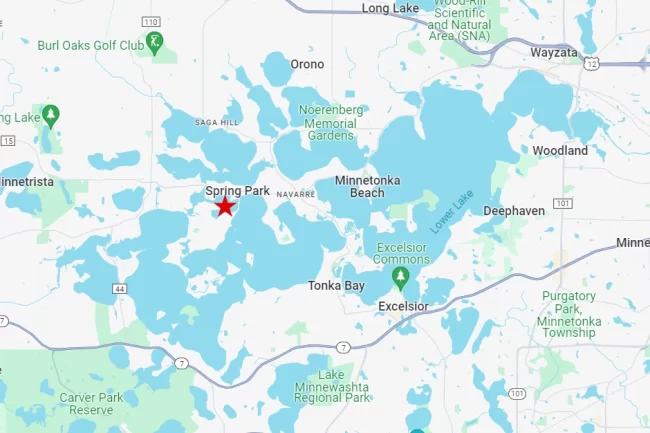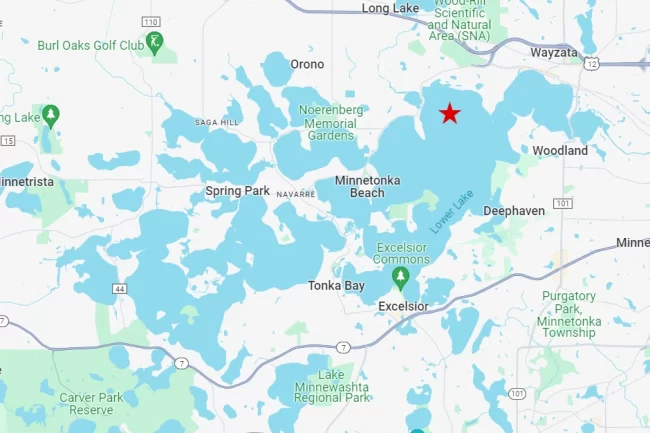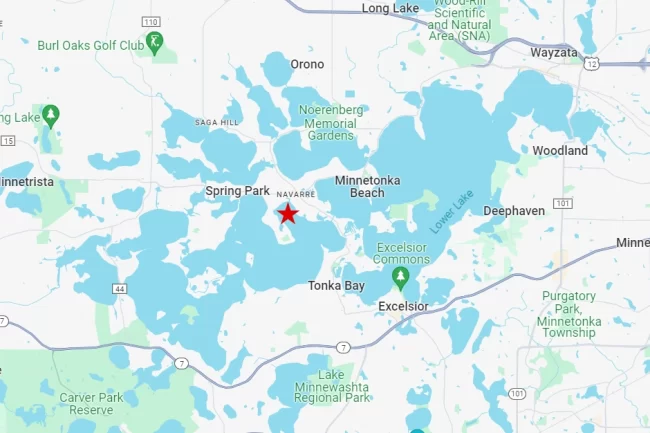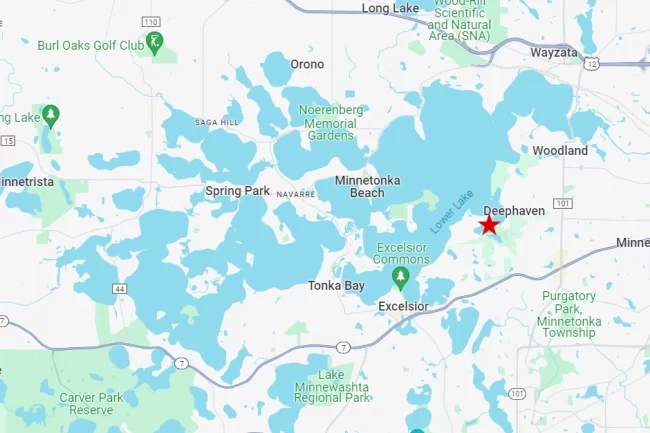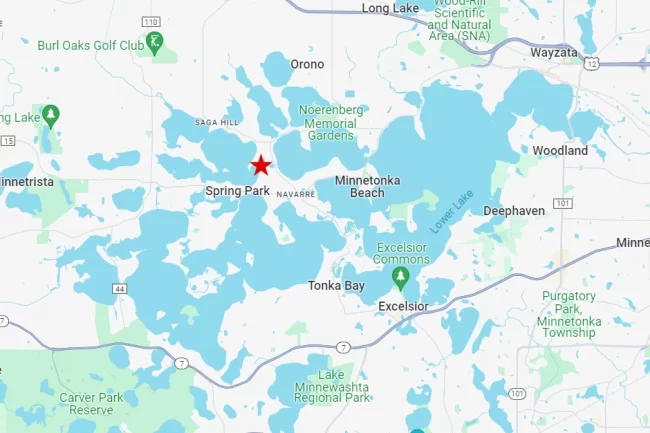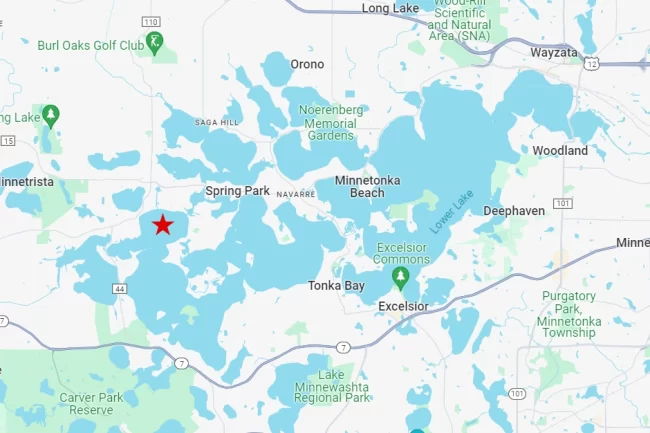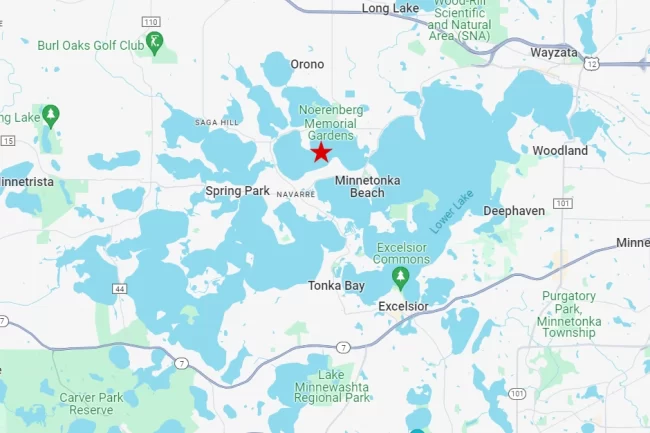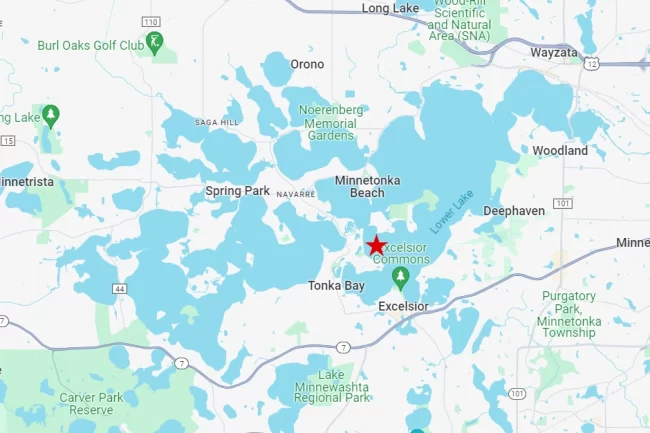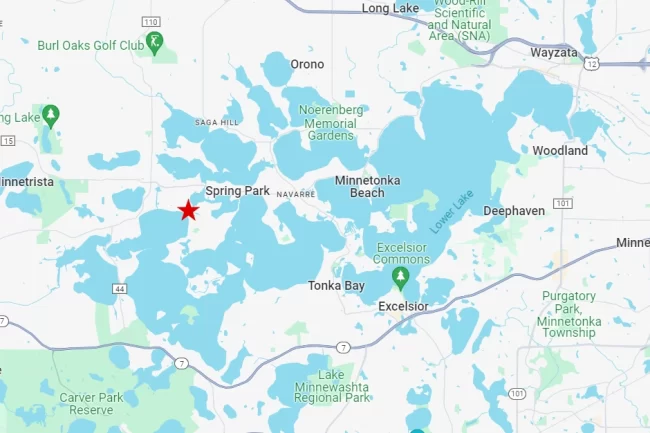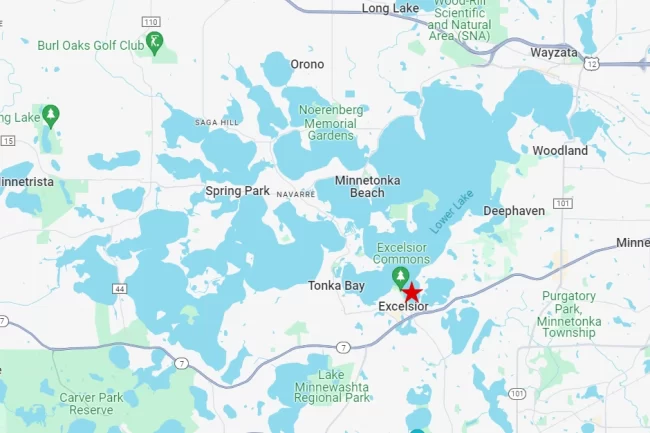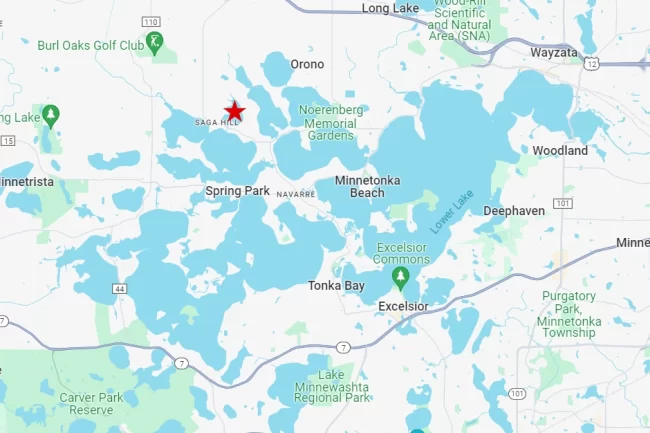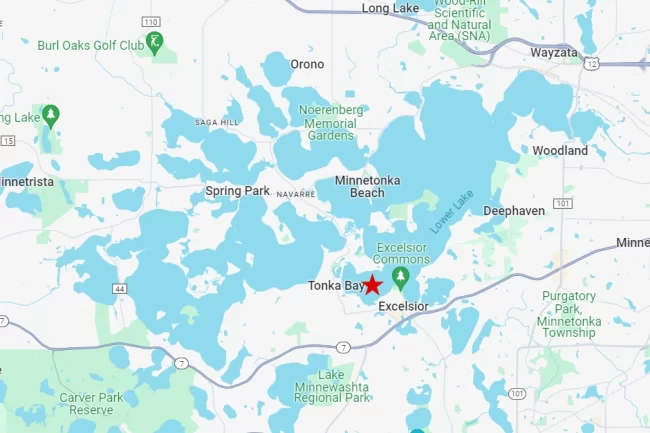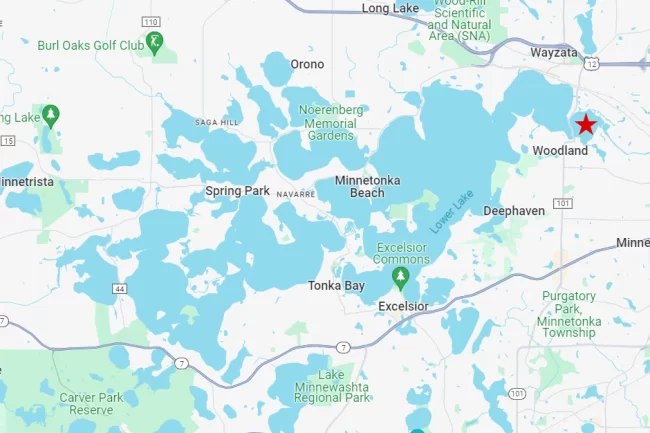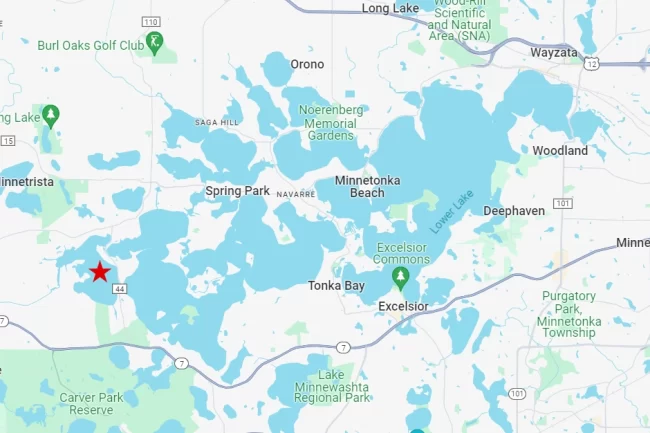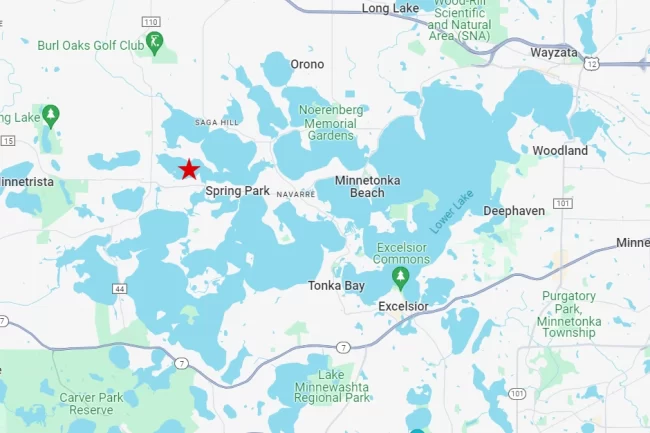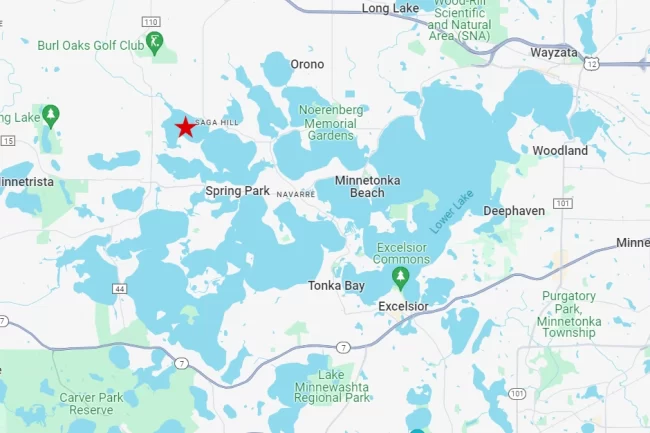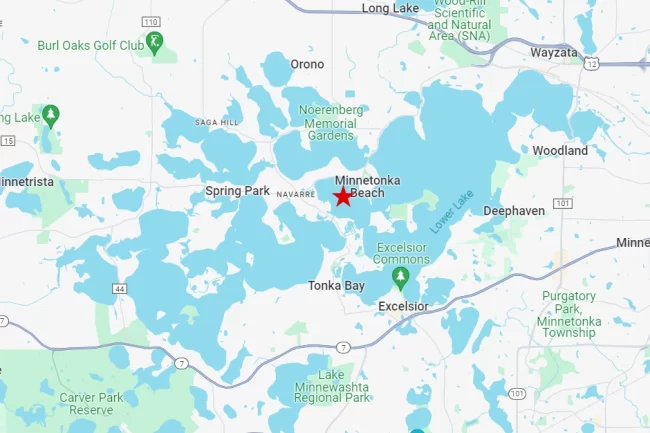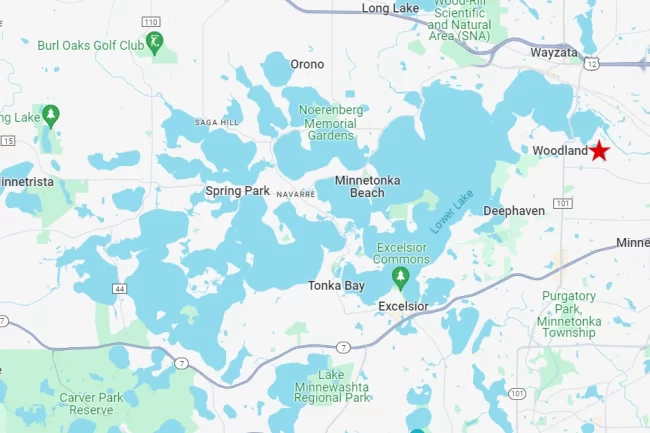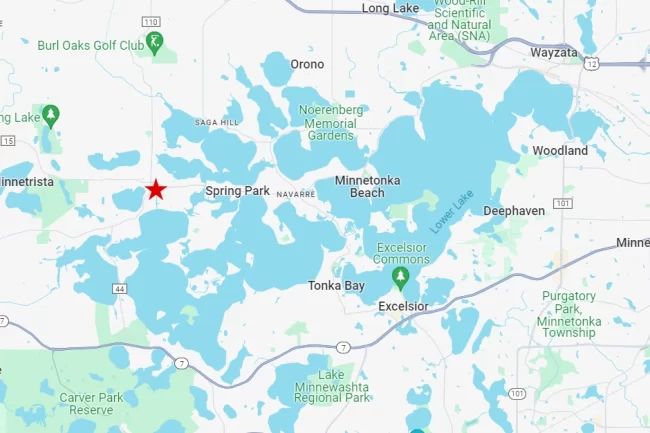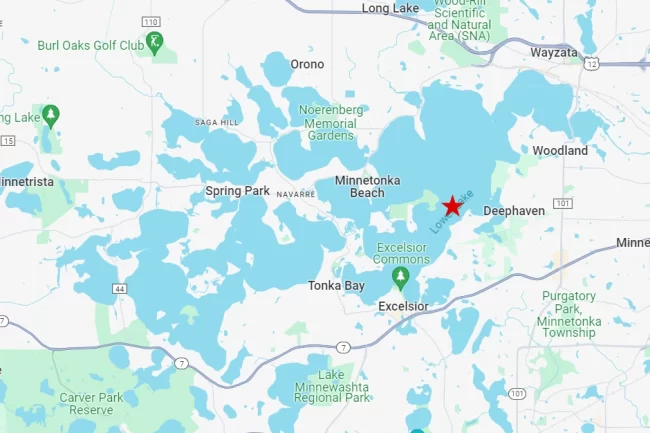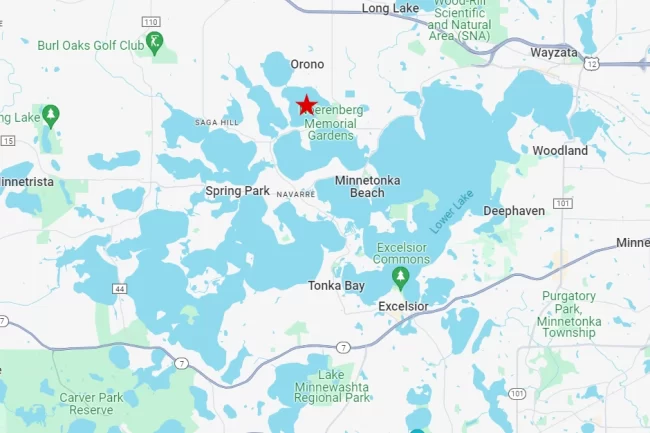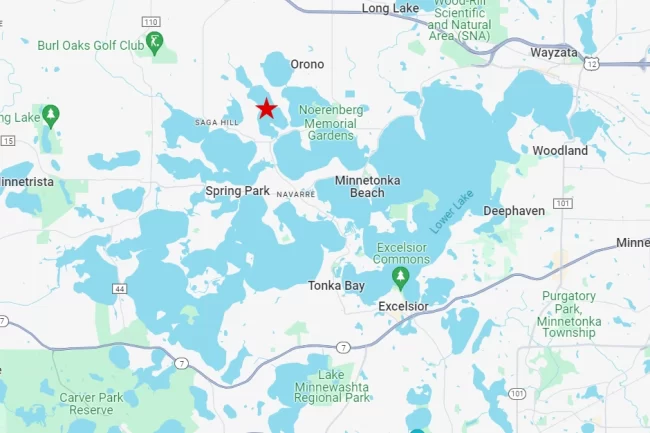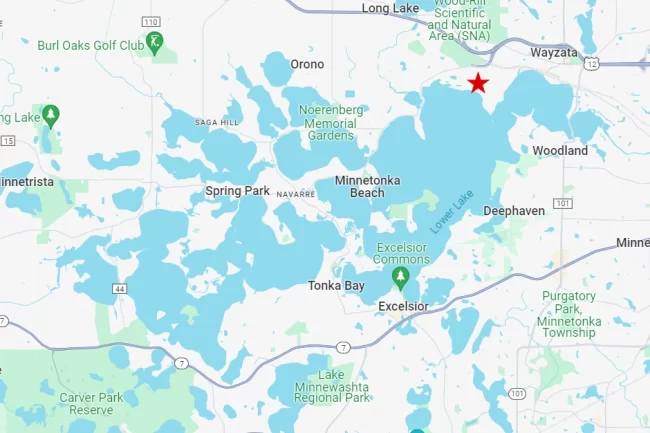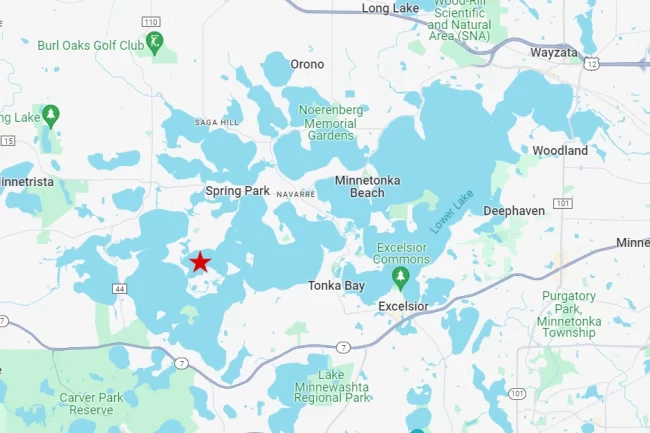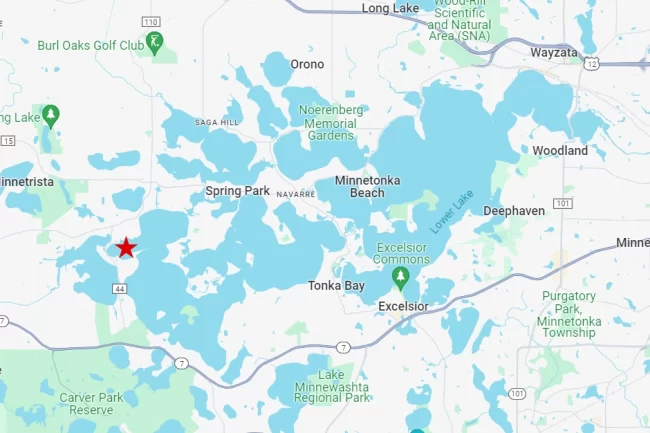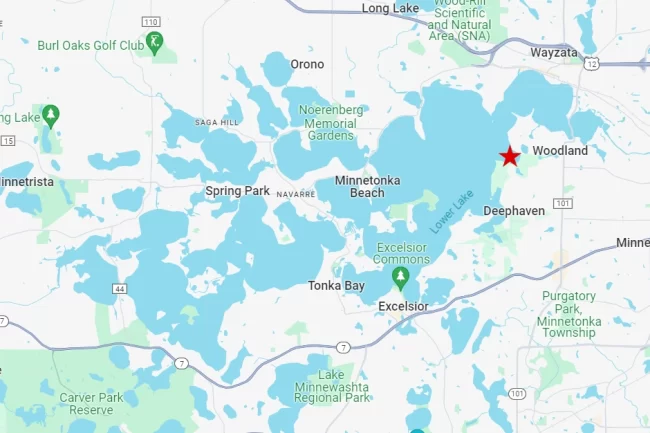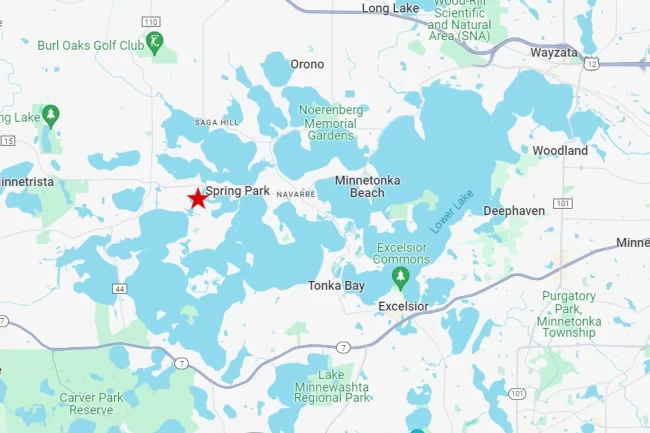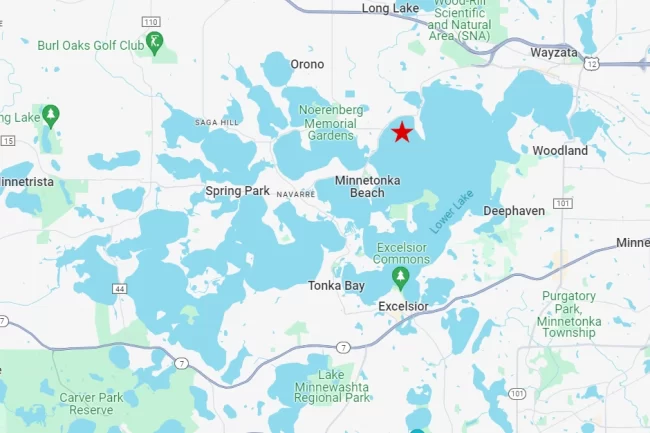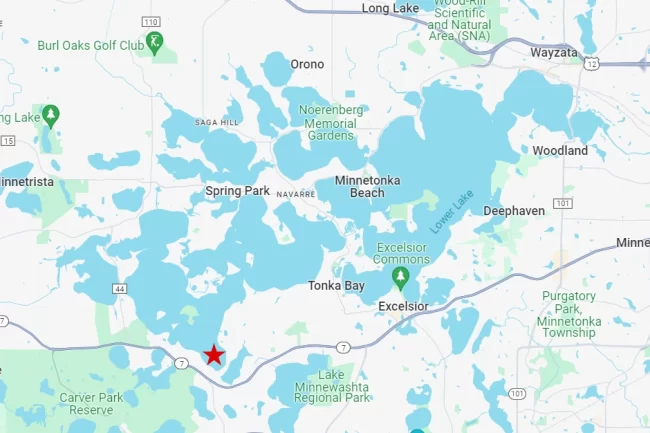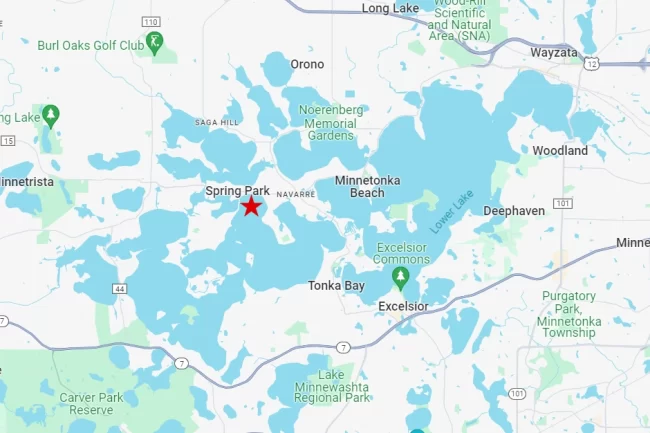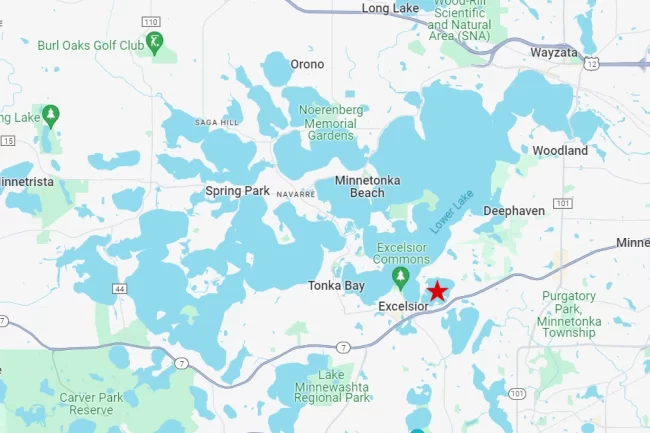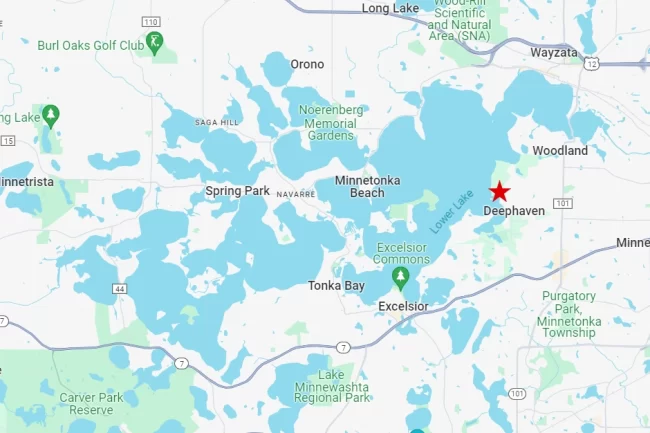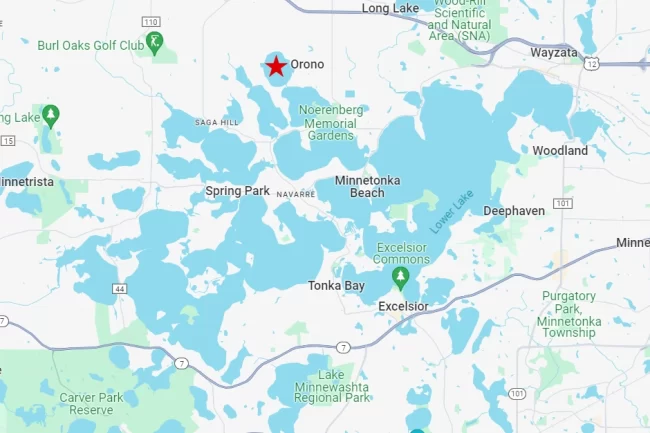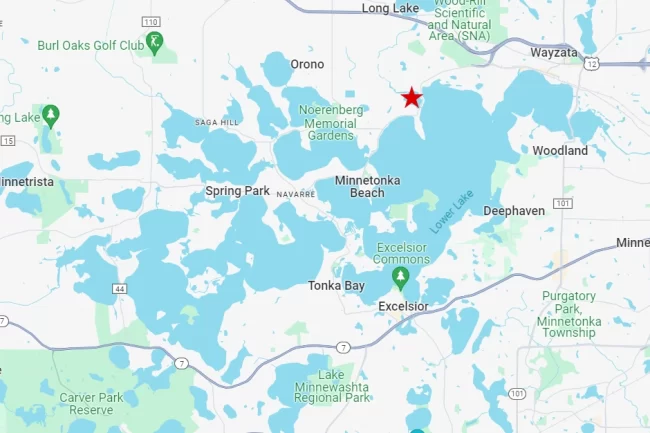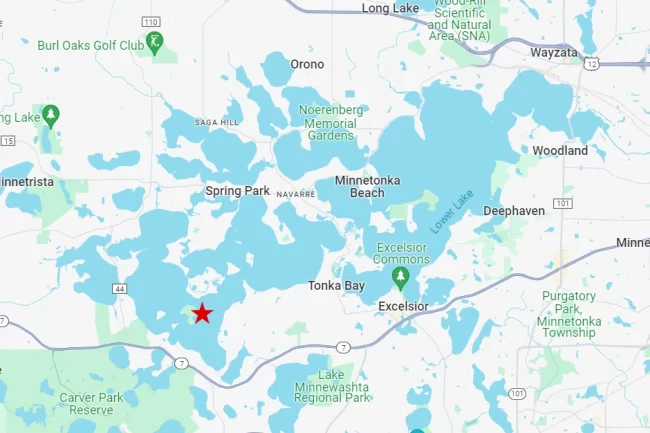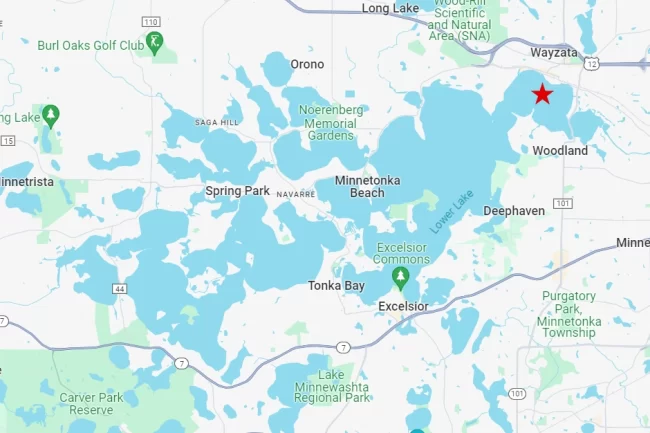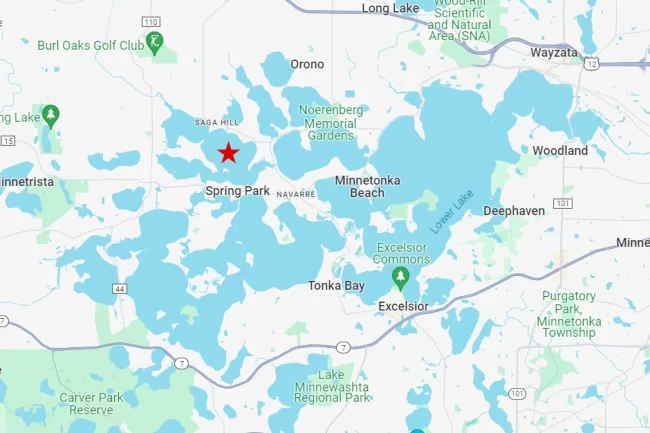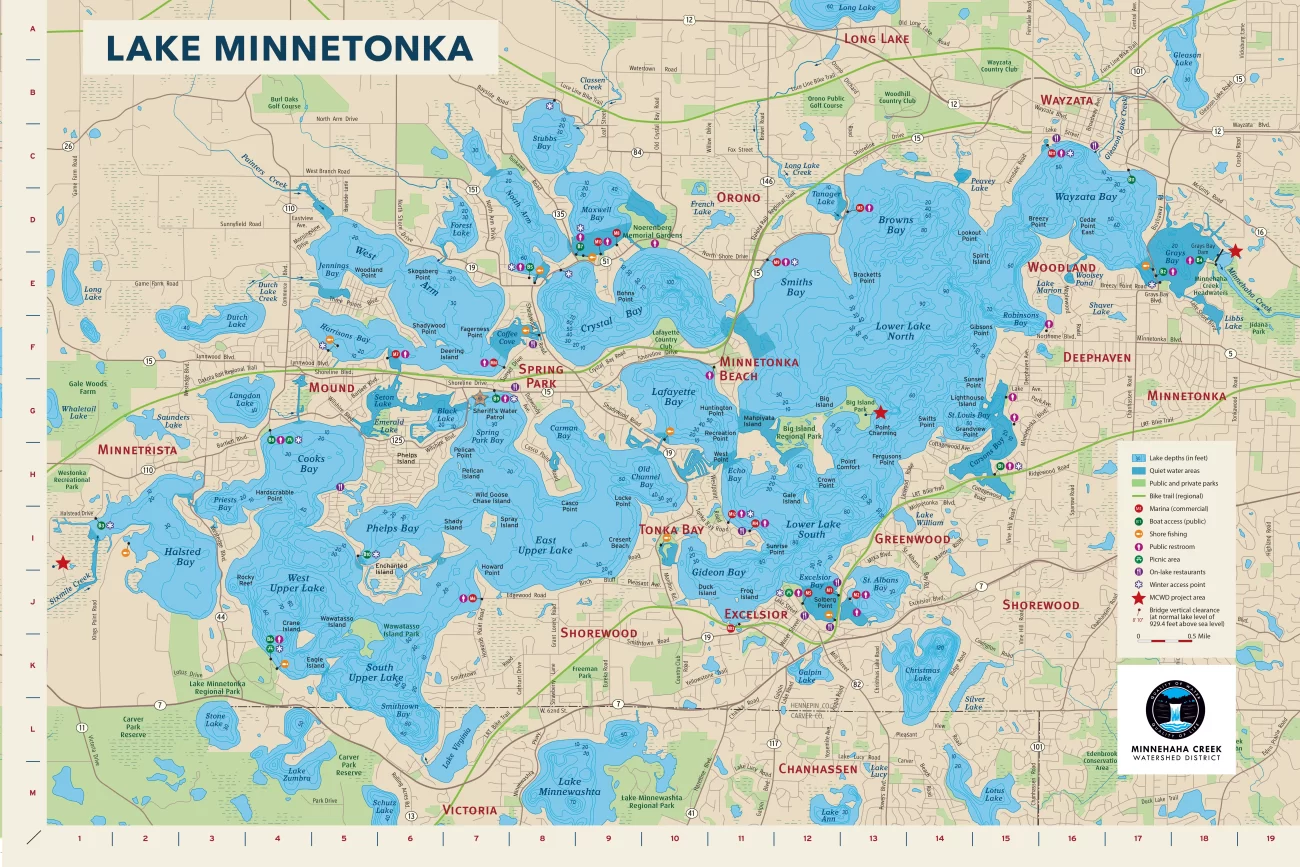
Welcome to David Gooden & Co’s Guide to the Bays on Lake Minnetonka. David is the co-founder of LakePlace.com, the largest and most visited lakeshore real estate platform in the Midwest. With more than 20 years of real estate industry experience, 7,500 successful transactions and approaching $3B in career sales, you can count on David Gooden to be your trusted guide on the purchase or sale of your Lake Minnetonka property. Contact David directly by email or text/call him at 612-367-6025.
Lake Minnetonka, one of Minnesota’s most iconic and expansive lakes, is renowned for its many picturesque bays, each offering a unique setting for lakefront living, recreation, and natural beauty. With its intricate network of over 30 bays, Lake Minnetonka provides a variety of scenic views and waterfront experiences, ranging from the serene and secluded to the lively and social. This guide will delve into the characteristics of each bay, providing insights into their distinct features and the types of homes, activities, and lifestyles they offer.
In addition to its famous bays, Lake Minnetonka is also home to several notable points and islands that add to the lake’s diverse geography. Points like Hardscrabble Point and Gideon Point create natural boundaries between bays, while islands such as Big Island and Enchanted Island offer exclusive retreats and unique landscapes. Together, the bays, points, and islands form the complex and captivating shoreline that makes Lake Minnetonka one of the most desirable waterfront destinations in the Midwest.
-
Black Lake
Black Lake on Lake Minnetonka is a peaceful bay located near the cities of Spring Park and Mound, Minnesota. It is connected to Spring Park Bay via a narrow channel and offers easy access to the larger lake while maintaining a quieter, more secluded atmosphere. The lake is surrounded by beautiful homes, many with private docks and scenic water views. With its calm waters and close proximity to restaurants and amenities in the nearby communities, Black Lake is an attractive location for those seeking a tranquil lakeside lifestyle on Lake Minnetonka.
Historically, the area around Black Bay was part of the land inhabited by the Dakota people before European settlement in the mid-19th century. The bay is named for its darker, deeper waters compared to other parts of the lake. Black Bay spans approximately 100 acres and reaches depths of up to 40 feet, making it suitable for various water activities, including fishing and boating. While not as developed as some of the larger bays on Lake Minnetonka, Black Bay features a mix of older, established homes and newer, luxurious waterfront properties, attracting those who value privacy and tranquility. (MN DNR) (Map)
-
Browns Bay
Browns Bay on Lake Minnetonka is a scenic and popular bay situated near the vibrant community of Wayzata, Minnesota. Known for its beautiful shoreline, Browns Bay offers residents and visitors a mix of luxurious lakeside homes and easy access to boating and water activities. The bay is connected to Smiths Bay to the east and Crystal Bay to the west, making it a well-positioned hub for exploring the lake. Browns Bay’s proximity to Wayzata provides homeowners with the convenience of upscale dining, boutique shopping, and entertainment, making it a desirable location for those seeking both luxury and lakeside living.
Browns bay covers approximately 150 acres and reaches a maximum depth of about 40 feet, making it suitable for boating, fishing, and swimming. Historically, Browns Bay was a favored location for early lake cottages and later became home to more permanent residences as Lake Minnetonka evolved into a popular year-round destination. Today, the bay is surrounded by a mix of historic and modern homes, with many waterfront properties offering expansive views and direct lake access. (Map)
-
Carman Bay
Carman Bay on Lake Minnetonka is a picturesque bay located near the city of Shorewood, Minnesota, offering a blend of serene waterfront living and convenient lake access. This bay is known for its clear waters and peaceful ambiance, making it a favorite for boating, fishing, and enjoying the scenic beauty of Lake Minnetonka. Carman Bay connects to Old Channel Bay and East Upper Lake, providing homeowners with easy navigation to other parts of the lake. The bay is lined with beautiful lakeside homes, many of which feature private docks and expansive views. Its proximity to Shorewood and Excelsior adds to the appeal, offering residents quick access to charming shops, restaurants, and local attractions, making Carman Bay a sought-after destination for those looking to enjoy luxury lakeside living.
Carman bay covers approximately 140 acres and has an average depth of around 20 feet. It was named after George Carman, an early settler in the area who played a significant role in the development of the surrounding land. Carman Bay’s tranquil waters and proximity to Excelsior made it a popular spot for early lake cottages and vacation homes, many of which have since been replaced by larger, more modern residences. Historically, the bay was known for its calm and sheltered location, which made it ideal for boating and fishing. (Map)
-
Carsons Bay
Carsons Bay on Lake Minnetonka is a charming and secluded bay located near the prestigious city of Deephaven, Minnesota. This tranquil bay is known for its calm waters, making it an ideal spot for boating, paddleboarding, and enjoying serene lakeside views. Carsons Bay is surrounded by stunning waterfront homes, many with private docks and expansive lake vistas, offering residents a peaceful retreat with easy access to the larger lake. Its location near Deephaven provides a perfect balance between privacy and proximity to local amenities, including parks, trails, and the popular nearby communities of Excelsior and Wayzata. Carsons Bay offers a unique blend of luxury living and natural beauty, making it a highly desirable location on Lake Minnetonka.
Carsons bay covers roughly 100 acres and has a maximum depth of around 40 feet. It is named after John Carson, an early settler and businessman who established himself in the area during the late 19th century. In the early 1900s, Carsons Bay was a popular site for lakefront cottages and summer homes, reflecting the growing trend of Minneapolis residents seeking vacation retreats on Lake Minnetonka. As the area developed, many of the original summer cottages were replaced with year-round homes, though the bay has retained its quiet and residential character. Carsons Bay is known for its sheltered waters, making it an excellent spot for boating and fishing, and it remains one of the more exclusive residential areas on the lake today. (MN DNR) (Map)
-
Coffee Cove
Coffee Cove on Lake Minnetonka is a peaceful and intimate inlet located near the city of Orono, Minnesota. This small cove offers a serene setting with calm waters, making it a perfect spot for kayaking, paddleboarding, and enjoying the natural beauty of Lake Minnetonka. Coffee Cove is tucked away from the busier areas of the lake, providing homeowners with a sense of privacy while still having access to the lake’s many recreational opportunities. The surrounding area features beautiful homes, many with private docks and lush, wooded landscapes. Its quiet ambiance and secluded charm make Coffee Cove a hidden gem for those seeking a tranquil lakeside lifestyle.
Covering just a few acres, it is one of the more intimate and lesser-known areas of the lake. Historically, Coffee Cove was part of the land owned by early settlers in the late 19th century, although it remained relatively undeveloped compared to the busier sections of Lake Minnetonka. The cove’s calm, sheltered waters made it an ideal spot for small fishing boats and leisurely water activities. Over time, the area became a quiet residential enclave, with a handful of private homes lining its shore. The cove remains a hidden gem on the lake, offering privacy and tranquility while still being connected to the larger waters of Lake Minnetonka. (Map)
-
Cooks Bay
Cooks Bay on Lake Minnetonka is one of the lake’s larger and more prominent bays, located near the communities of Mound and Spring Park, Minnesota. Known for its wide open waters, Cooks Bay is a popular spot for boating, fishing, and water sports. The bay offers stunning views and a vibrant lakeside atmosphere, with many waterfront homes featuring private docks and expansive shorelines. Connected to Seton Lake and Priests Bay, Cooks Bay provides easy access to other parts of Lake Minnetonka, making it a central hub for lake activities. Its surrounding neighborhoods offer a blend of charming small-town living and close proximity to dining, shopping, and entertainment options, making Cooks Bay a highly desirable location for those looking to enjoy both luxury lakeside living and the active Lake Minnetonka lifestyle.
Covering approximately 550 acres, Cooks Bay has an average depth of 15 feet and a maximum depth of around 40 feet, making it ideal for boating, fishing, and other recreational activities. The bay is named after early settler James Cook, who was instrumental in the area’s development during the late 1800s when Lake Minnetonka became a popular vacation destination. In the early 20th century, Cooks Bay was home to several resorts, contributing to the region’s tourism boom. Over time, these resorts gave way to permanent residential development, and today, Cooks Bay is surrounded by a mix of historic homes and modern lakeside properties. The bay remains a central hub for lake activity, with numerous public access points and marinas along its shoreline. (Map)
-
Crystal Bay
Crystal Bay on Lake Minnetonka is a stunning and expansive bay located near the cities of Orono and Minnetonka Beach, Minnesota. Known for its crystal-clear waters and picturesque shoreline, Crystal Bay is a popular destination for boating, fishing, and lakeside recreation. The bay is surrounded by luxurious homes, many with private docks and panoramic views of the lake, offering residents a perfect blend of natural beauty and upscale living. Connected to Maxwell Bay and Browns Bay, Crystal Bay provides easy navigation to other parts of Lake Minnetonka. Its prime location near parks, trails, and the charming town of Wayzata makes it a sought-after area for those seeking both the tranquility of lakefront living and convenient access to local amenities.
Covering approximately 880 acres, Crystal Bay has an average depth of 30 feet and reaches a maximum depth of 68 feet, making it one of the deeper bays on the lake. The bay was named for its clear waters and has been a popular destination since the late 1800s when Lake Minnetonka became a renowned resort area. During the late 19th and early 20th centuries, steamboats frequently traveled across Crystal Bay, transporting visitors to grand hotels and resorts that once lined its shores. (MN DNR) (Map)
-
Echo Bay
Echo Bay on Lake Minnetonka is a peaceful and scenic bay nestled between the communities of Tonka Bay and Greenwood, Minnesota. Known for its calm waters and natural beauty, Echo Bay offers a tranquil retreat for those seeking a quieter lakeside lifestyle. The bay is surrounded by beautiful lake homes, many with private docks and stunning views of the water. Echo Bay’s serene atmosphere makes it ideal for kayaking, paddleboarding, and enjoying nature, while still providing easy access to the larger lake for boating and recreation. Its proximity to charming local amenities in Deephaven and Excelsior, along with its secluded charm, makes Echo Bay a highly desirable location for lakeshore living on Lake Minnetonka.
The bay covers approximately 100 acres and is known for its calm, sheltered waters. In the early days of Lake Minnetonka’s popularity, Echo Bay was a favored spot for boating and fishing, drawing visitors who traveled by steamboat to enjoy the lake’s natural beauty. Its proximity to Excelsior, a bustling resort town at the time, made it a convenient and scenic destination for summer tourists. Echo Bay’s tranquil waters continue to reflect its historical role as a peaceful retreat on one of Minnesota’s most famous lakes. (Map)
-
Emerald Lake
Emerald Lake on Lake Minnetonka is a serene and tucked-away bay located in the city of Minnetrista, Minnesota (and Mound, MN). Known for its peaceful, clear waters, Emerald Lake provides a quiet and picturesque setting for lakeside living. The bay is surrounded by beautiful homes, many with private docks and wooded landscapes, offering a sense of seclusion and connection to nature. Emerald Lake is connected to Cooks Bay, allowing residents easy access to the larger lake while maintaining a more private and calm environment. Its tranquil ambiance, combined with proximity to nearby parks and the local amenities of Minnetrista and Mound, makes Emerald Lake a sought-after destination for those seeking a peaceful retreat on Lake Minnetonka.
Historically, Emerald Lake played a role in the lake’s broader recreational history, particularly during the late 19th and early 20th centuries when Lake Minnetonka was a major tourist destination. The bay covers roughly 70 acres and is known for its clear, calm waters, making it a favorite spot for fishing and quieter boating activities. Emerald Lake is connected to Cooks Bay via a narrow channel, providing a sheltered area for early steamboats and smaller vessels that navigated the lake. Its name likely derives from the greenish hue of the water, which has long been admired by locals and visitors alike. Emerald Lake remains a quieter section of the lake, with a strong connection to the area’s historical recreational use. (MN DNR) (Map)
-
Excelsior Bay
Excelsior Bay on Lake Minnetonka is a lively and picturesque bay located near the vibrant town of Excelsior, Minnesota. Known for its active waterfront and bustling marina, Excelsior Bay is a popular hub for boating, water sports, and lakeside recreation. The bay is surrounded by beautiful homes and condos, many offering stunning views of the water and easy access to the lake. Excelsior Bay’s proximity to the historic downtown Excelsior area provides residents and visitors with a wealth of dining, shopping, and entertainment options, all within walking distance. Its unique blend of lakeside charm and community activity makes Excelsior Bay a highly desirable location for those looking to enjoy both luxury living and the lively atmosphere of Lake Minnetonka.
In the late 19th and early 20th centuries, Excelsior Bay was a major hub for tourism, as steamboats brought visitors to Excelsior Amusement Park, which opened in 1925 and became a beloved lakeside attraction for decades. The bay covers approximately 180 acres and is connected to both Gideon and St. Albans bays. Excelsior Bay was also central to the steamboat routes that traversed Lake Minnetonka, playing a key role in the area’s early resort and tourism industry. It remains a historically rich part of the lake, with a deep connection to the area’s development as a popular destination for recreation and leisure. (Map)
-
Forest Lake
Forest Lake on Lake Minnetonka is a quiet and picturesque bay located in the city of Orono, Minnesota. Known for its peaceful ambiance and scenic wooded surroundings, Forest Lake offers a tranquil retreat for residents seeking a serene lakeside lifestyle. The bay is dotted with beautiful waterfront homes, many with private docks and expansive views of the water. Forest Lake connects to West Arm, giving homeowners easy access to the broader Lake Minnetonka for boating and water activities. Its close proximity to nearby parks, trails, and the charming town of Wayzata makes Forest Lake a sought-after location for those desiring a perfect blend of natural beauty and convenience.
Covering roughly 45 acres, Forest Lake is known for its calm and shallow waters, making it a popular spot for fishing and quiet boating activities in the late 19th and early 20th centuries when Lake Minnetonka was a major destination for tourists and locals alike. Historically, Forest Lake was a quiet retreat compared to the busier areas of the lake, offering a more secluded experience for visitors. (Map)
-
Gideon Bay
Gideon Bay on Lake Minnetonka is a serene and scenic bay located near the cities of Shorewood and Excelsior, Minnesota. Known for its calm waters and lush surroundings, Gideon Bay offers a peaceful lakeside retreat while still providing easy access to the rest of the lake. The bay is home to a collection of stunning waterfront properties, many with private docks and sweeping views of the lake’s natural beauty. Its proximity to the lively town of Excelsior adds to its appeal, with residents enjoying close access to dining, shopping, and entertainment options. Gideon Bay’s quiet atmosphere and convenient location make it an ideal spot for those seeking a blend of luxury lakeside living and the charm of Lake Minnetonka’s vibrant community life.
Covering approximately 185 acres, the bay was named after Gideon Hollister Pond, an early missionary and settler who lived in the area in the mid-1800s. In the late 19th century, Gideon Bay was a favored location for boating and fishing, and it played a role in the bustling steamboat era when Lake Minnetonka was a major resort destination. The bay’s calm waters made it an ideal spot for leisure activities, and its connection to Excelsior Bay further increased its accessibility during the steamboat boom. (Map)
-
Grays Bay
Grays Bay on Lake Minnetonka is a beautiful and highly sought-after bay located near the city of Minnetonka, Minnesota. As the easternmost bay on the lake, Grays Bay serves as the headwaters of Minnehaha Creek, offering a unique blend of natural beauty and easy access to both the lake and the surrounding parks. The bay is known for its calm waters, making it perfect for boating, fishing, and kayaking. Grays Bay is lined with luxurious lakeside homes, many with private docks and expansive water views. Its prime location near downtown Wayzata and major highways offers residents the convenience of nearby shopping, dining, and entertainment, all while enjoying the tranquility of lakefront living. With its scenic shoreline and peaceful atmosphere, Grays Bay is one of the most desirable areas on Lake Minnetonka.
Grays Bay holds historical significance as the source of Minnehaha Creek, which flows from the lake toward the iconic Minnehaha Falls in Minneapolis. Covering roughly 228 acres, Grays Bay played a pivotal role in the lake’s early transportation history, as it was one of the main entry points for boats and travelers arriving from nearby communities. In the late 1800s, it served as a key location for steamboats transporting visitors across the lake during Lake Minnetonka’s resort era. The bay’s relatively shallow depth and sheltered waters made it an ideal spot for fishing, boating, and other leisure activities. Grays Bay’s connection to Minnehaha Creek and its historical significance in the region’s transportation and recreation make it an important part of Lake Minnetonka’s history. (MN DNR) (Map)
-
Halsted Bay
Halsted Bay (often spelled Halstead Bay), located on the western edge of Lake Minnetonka near the city of Minnetrista, is a peaceful and expansive bay known for its wide-open waters and scenic surroundings. This tranquil bay is a favorite for boaters and anglers, offering a quieter experience compared to some of the more bustling bays on the lake. Homes along Halsted Bay are spacious and often feature large waterfront lots with private docks, providing residents with beautiful views and direct access to the lake. The bay connects to other parts of Lake Minnetonka, making it ideal for those seeking a serene, lakeside lifestyle with the convenience of being close to parks, trails, and the charming towns of Minnetrista and Mound. Its combination of natural beauty and peaceful living makes Halsted Bay a hidden gem on Lake Minnetonka.
Halsted Bay is one of the lake’s largest bays, covering approximately 670 acres. Historically, Halsted Bay played a significant role in the lake’s commercial and agricultural development in the 19th century. It was named after early settler James Halsted, who was instrumental in the local farming community. Unlike the more developed eastern bays, Halsted Bay remained relatively untouched during Lake Minnetonka’s resort boom, providing a more natural and less trafficked area for fishing and boating. The bay’s expansive size and depth, reaching up to 50 feet, made it ideal for early recreational activities and commercial fishing. Today, Halsted Bay stands as a reminder of the lake’s quieter, more rural past, with its deep waters and historical connection to the area’s early settlers. (MN DNR) (Map)
-
Harrisons Bay
Harrisons Bay on Lake Minnetonka is a quiet and picturesque bay located near the city of Mound, Minnesota. Known for its serene waters and beautiful natural surroundings, Harrisons Bay offers a peaceful escape for lakeside living. The bay is lined with charming waterfront homes, many featuring private docks and large lots, perfect for those seeking a close connection to the water. With easy access to nearby Seton Lake and West Arm Bay, Harrisons Bay provides an excellent location for boating and other water activities. The bay’s proximity to Mound and Spring Park offers residents convenient access to local amenities, parks, and trails, making Harrisons Bay an ideal spot for those looking to enjoy the tranquility of Lake Minnetonka while still being close to community conveniences.
Covering approximately 135 acres, the bay is named after early settler Harrison B. Gates, who was one of the first to establish a homestead in the area during the mid-1800s. In the late 19th and early 20th centuries, Harrisons Bay was a hub for recreational activities such as fishing and boating, and its calm, sheltered waters made it a popular spot for local fishermen. The bay is relatively shallow, with an average depth of 15 feet, making it ideal for these activities. Additionally, Harrisons Bay was part of the steamboat routes that transported tourists around the lake during Lake Minnetonka’s resort era, contributing to the area’s growth as a recreational destination. (Map)
-
Jennings Bay
Jennings Bay on Lake Minnetonka is a peaceful and expansive bay located near the cities of Mound, Orono, and Minnetrista. Known for its calm waters and scenic beauty, Jennings Bay offers a tranquil setting ideal for boating, fishing, and lakeside relaxation. The bay is home to a variety of waterfront properties, ranging from cozy lake cabins to expansive luxury homes, many with private docks and sweeping views of the water. Jennings Bay is well-connected to other parts of Lake Minnetonka, providing easy access to nearby channels and bays for those who enjoy exploring the lake. Its location near parks, trails, and the charming small-town amenities of Mound makes Jennings Bay a desirable spot for those seeking a serene lakeside lifestyle with the convenience of nearby community resources.
Jennings Bay spans approximately 290 acres and has a maximum depth of 40 feet. Historically, Jennings Bay played an important role in the lake’s early recreational and commercial fishing industries during the late 19th and early 20th centuries. The bay was named after the Jennings family, early settlers who contributed to the development of the area. Jennings Bay’s relatively calm and protected waters made it a favored location for fishing and ice harvesting, activities that were essential to the local economy at the time. (MN DNR) (Map)
-
Lafayette Bay
Lafayette Bay on Lake Minnetonka is a prestigious and picturesque bay located near the cities of Minnetonka Beach and Orono. Known for its calm waters and expansive shoreline, Lafayette Bay is home to some of the most luxurious waterfront estates on the lake, many featuring private docks, lush landscaping, and breathtaking lake views. The bay’s peaceful atmosphere makes it perfect for boating, kayaking, and enjoying the natural beauty of Lake Minnetonka. Its proximity to the Lafayette Club, a historic lakeside country club, adds to the appeal of the area, offering residents access to golf, tennis, and dining. With easy access to other parts of the lake and close to the nearby communities of Wayzata and Orono, Lafayette Bay offers a perfect blend of luxury lakeside living and convenience, making it one of the most coveted bays on Lake Minnetonka.
Lafayette Bay spans approximately 250 acres and has a depth of around 45 feet, making it one of the deeper and more navigable parts of the lake. Named after the French Revolutionary War hero Marquis de Lafayette, the bay was a significant location during the late 19th century when steamboat travel was a primary mode of transportation for tourists visiting Lake Minnetonka. One of the key landmarks on Lafayette Bay is the Lafayette Club, established in 1882, which became a central gathering spot for the social elite of Minneapolis and beyond. (Map)
-
Libbs Lake
Libbs Lake is a charming and secluded bay on Lake Minnetonka, located in the city of Minnetonka, Minnesota. Connected to Grays Bay by a narrow channel, Libbs Lake offers a peaceful and private setting for lakeside living. The bay is surrounded by beautiful waterfront homes, many with private docks, offering a serene retreat from the busier areas of the lake. Libbs Lake’s calm waters are ideal for kayaking, paddleboarding, and enjoying quiet moments on the lake. Its location near major amenities in Minnetonka and the nearby town of Wayzata provides the perfect balance between tranquility and convenience. For those seeking a quiet lakeside lifestyle with easy access to the larger Lake Minnetonka, Libbs Lake is a hidden gem.
This quiet body of water covers approximately 35 acres and is connected to Grays Bay by a narrow channel, making it one of the more hidden sections of the lake. Historically, Libbs Lake was a favored fishing spot due to its calm and shallow waters, with a maximum depth of about 15 feet. The bay played a role in the early recreational activities on Lake Minnetonka, particularly in the late 19th and early 20th centuries when the lake was a bustling tourist destination. (Map)
-
Lost Lake
Lost Lake on Lake Minnetonka is a peaceful and intimate bay located in the city of Mound, Minnesota. Known for its quiet and sheltered waters, Lost Lake is connected to the larger Cooks Bay by a slow-wake channel, offering residents the perfect balance of privacy and access to Lake Minnetonka’s broader waters. The bay is home to the Villas on Lost Lake, a charming townhome community that offers beautiful waterfront living with private docks and scenic lake views. Lost Lake’s calm atmosphere makes it ideal for kayaking, paddleboarding, and enjoying the serenity of lakeside life. Its location in Mound provides residents with close proximity to parks, trails, and local amenities, making Lost Lake a desirable spot for those seeking a peaceful retreat with the convenience of nearby community resources.
Covering roughly 50 acres, Lost Lake played an important role in the region’s early transportation history. In the late 19th century, the lake was a hub for steamboat travel, and Lost Lake was the site of one of the boatyards used for constructing and maintaining the steamers that ferried passengers across Lake Minnetonka. Additionally, the nearby rail lines, part of the Great Northern Railway, connected Lost Lake to the broader transportation network, making it a critical link between water and rail travel. Its sheltered and relatively shallow waters, with a maximum depth of about 10 feet, contributed to its historical use as a strategic location for these early commercial activities. (Map)
-
Lower Lake
Lower Lake on Lake Minnetonka, also known as Lower Lake Minnetonka, has been a central part of the lake’s historical development, particularly during the late 19th and early 20th centuries when the lake became a major resort destination. Covering a vast area that includes several key bays such as Wayzata Bay, Browns Bay, and Excelsior Bay, Lower Lake was a primary hub for steamboat traffic. During the height of Lake Minnetonka’s tourism era, steamboats would ferry passengers across Lower Lake to various hotels, resorts, and attractions, including Big Island, which became famous for its amusement park that opened in 1906. This park drew thousands of visitors until it closed in 1911, leaving a lasting legacy in the area’s recreational history.
The deep waters of Lower Lake, which can reach depths of up to 113 feet, made it an ideal route for larger vessels, including steamboats and excursion boats that were essential for transporting visitors and goods around the lake. This section of Lake Minnetonka became the heart of social and recreational life, with the area hosting regattas, boating events, and other social gatherings that attracted visitors from Minneapolis and beyond. Additionally, the lake’s connection to Minnehaha Creek and its proximity to Minneapolis made it a gateway for the expansion of tourism in the region, as visitors traveled by train and steamboat to enjoy the lake’s scenic beauty and leisure activities. Lower Lake’s role in shaping the cultural and recreational history of Lake Minnetonka remains a significant part of its legacy. (MN DNR) (Map)
-
Maxwell Bay
Maxwell Bay on Lake Minnetonka is a beautiful and sought-after bay located in Orono, Minnesota. Known for its expansive waters and stunning lakeside properties, Maxwell Bay offers a perfect blend of recreational opportunities and luxury living. The bay provides easy access to other parts of Lake Minnetonka, connecting to Crystal Bay and Stubbs Bay via scenic channels. Home to landmarks such as the North Shore Marina, Wayzata Marine, and Noerenberg Memorial Gardens, Maxwell Bay is a hub for both boating enthusiasts and nature lovers. Waterfront homes on the bay often feature private docks and breathtaking views, making it an ideal location for those seeking a premier lakeside lifestyle. Its proximity to parks, trails, and nearby Wayzata adds to the convenience, offering both serenity and easy access to local amenities.
Maxwell Bay covers approximately 220 acres and is known for its clear, navigable waters, which made it an ideal spot for boating and fishing during Lake Minnetonka’s resort era in the late 19th and early 20th centuries. Maxwell Bay was a popular area for steamboat travel, serving as a key passage for tourists exploring the lake’s many attractions. Its proximity to Noerenberg Memorial Gardens, a well-known public estate garden established in the early 1900s by the Noerenberg family, added to its historical significance. (MN DNR) (Map)
-
North Arm
North Arm on Lake Minnetonka is a serene and picturesque bay located in Orono, Minnesota. Known for its quiet waters and natural beauty, North Arm is a favorite among boaters and anglers looking for a peaceful retreat. The bay is surrounded by a mix of beautiful lake homes, many with private docks and large, wooded lots, offering a tranquil and private lakeside lifestyle. North Arm connects to Maxwell Bay and the main body of Lake Minnetonka, making it easy for residents to explore the lake while still enjoying the calm and secluded atmosphere. The North Arm public boat launch is a popular feature, providing easy access for lake activities. With its serene environment, scenic shoreline, and proximity to nearby parks and trails, North Arm is an ideal location for those seeking a quiet and nature-filled experience on Lake Minnetonka.
North Arm covers approximately 340 acres and has an average depth of about 15 feet, making it one of the more shallow sections of the lake, ideal for fishing enthusiasts in the late 19th and early 20th centuries. During the steamboat era of Lake Minnetonka, North Arm was a quieter area compared to the bustling resort hubs but still played a role in the transportation routes of the time. The North Arm Public Boat Launch, established early on, made this bay easily accessible to both locals and visitors looking to explore the lake’s waters. (MN DNR) (Map)
-
Old Channel Bay
Old Channel Bay on Lake Minnetonka is a peaceful and scenic bay located in the city of Tonka Bay, Minnesota. This charming bay is connected to Carman Bay and East Upper Lake via a no-wake channel under Shadywood Road, offering a serene setting for boating, kayaking, and paddleboarding. Old Channel Bay is known for its calm waters and is surrounded by beautiful lake homes, many of which feature private docks and large, wooded lots that provide a sense of privacy and natural beauty. Locke Point, a prominent feature of the bay, adds to the scenic landscape. With easy access to other parts of Lake Minnetonka and the nearby communities of Excelsior and Tonka Bay, residents enjoy both tranquility and convenience. Old Channel Bay offers a perfect blend of serene lakeside living and access to all that Lake Minnetonka has to offer. (Map)
-
Peavey Lake
Peavey Lake on Lake Minnetonka is a small and secluded bay located in the prestigious city of Wayzata, Minnesota. Connected to Browns Bay by a narrow channel under Ferndale Road, Peavey Lake offers a tranquil and private setting for lakeside living. The bay is surrounded by luxury homes, many situated on large, wooded lots along Ferndale Road, Bovey Road, and Ferndale Woods Road – some of the most prestigious addresses on the lake. Known for its calm waters and quiet ambiance, Peavey Lake is ideal for those seeking a peaceful retreat while still being close to the vibrant amenities of Wayzata, including fine dining, boutique shopping, and cultural attractions. With its serene atmosphere and exclusivity, Peavey Lake is a highly desirable location for luxury waterfront living on Lake Minnetonka.
Peavey Lake, a small and quiet bay on Lake Minnetonka, covers approximately 50 acres. Historically, Peavey Lake was known for its calm, sheltered waters, which made it an ideal spot for fishing and more relaxed recreational activities in the late 19th and early 20th centuries. The bay is named after the prominent Peavey family, who were influential in Minnesota’s grain industry and had a lasting impact on the development of the area. (Map)
-
Phelps Bay
Phelps Bay on Lake Minnetonka is a picturesque and expansive bay located between the cities of Mound and Spring Park, Minnesota. Surrounded by a collection of small islands, including Phelps Island, Enchanted Island, and Shady Island, the bay offers a tranquil setting perfect for boating, fishing, and enjoying the scenic beauty of Lake Minnetonka. Phelps Bay is connected to East Upper Lake and West Upper Lake through a narrow, no-wake channel known as Zimmermans Pass, making it easy for residents to explore other parts of the lake. The bay is lined with beautiful lakeside homes, many featuring private docks and expansive water views. With its peaceful atmosphere, proximity to parks, trails, and local amenities in Mound and Spring Park, Phelps Bay is a desirable location for those seeking both the serenity of lakefront living and access to the vibrant community life of the Lake Minnetonka area.
Phelps Bay has played an important role in the lake’s recreational history – covering approximately 220 acres. Historically, Phelps Bay was a popular destination for boating and fishing, particularly during the late 19th and early 20th centuries when Lake Minnetonka was a major resort area. Phelps Bay’s calm waters and proximity to nearby recreational hubs made it an ideal spot for leisure activities and contributed to its significance in the overall history of Lake Minnetonka. (Map)
-
Priests Bay
Priests Bay on Lake Minnetonka is a peaceful and scenic bay located between Mound and Minnetrista, Minnesota. Known for its calm, clear waters and natural beauty, Priests Bay offers a tranquil setting perfect for lakeside living. The bay connects to both Halsted Bay and Cooks Bay through no-wake channels, providing easy access for boating while maintaining its serene ambiance. Homes along Priests Bay are often spacious, with many featuring private docks and large waterfront lots that offer stunning views of the lake. The bay is also home to Highland End Park, providing additional recreational opportunities for residents. With its secluded atmosphere and proximity to the amenities in Mound and Minnetrista, Priests Bay is a highly sought-after location for those looking to enjoy the quiet beauty of Lake Minnetonka.
Priests Bay, located on the western side of Lake Minnetonka, covers approximately 130 acres and has historical significance tied to the lake’s early settlement and recreational use. The bay is named after Catholic priests who visited the area during the mid-1800s, reflecting the religious influence in the early development of the region. Priests Bay connects to Halsted Bay and its waters flow into Cooks Bay to the northeast and West Upper Lake to the south. (Map)
-
Robinsons Bay
Robinsons Bay on Lake Minnetonka is a prestigious and serene bay nestled between the cities of Woodland and Deephaven, Minnesota. Known for its calm waters and luxurious lakeside estates, Robinsons Bay offers a peaceful retreat with a sense of exclusivity. The bay is surrounded by stunning waterfront homes along streets like Northome Boulevard and Robinsons Bay Road, many of which feature private docks and expansive views of the lake. With Gibson Point jutting out into the bay and the historic Northhome Stone Arch nearby, the area combines natural beauty with historic charm. Residents of Robinsons Bay enjoy easy access to nearby amenities in Deephaven and the larger lake, making it an ideal location for those seeking luxury lakeside living with a quiet, secluded atmosphere. (Map)
-
Seton Lake
Seton Lake, a tranquil bay on Lake Minnetonka, is located in the city of Mound, Minnesota, offering a peaceful retreat for lakeside living. Surrounded by wooded landscapes and charming homes, Seton Lake provides a calm and secluded atmosphere while still being connected to the larger lake system. The bay links to Cooks Bay, Emerald Lake, and Black Lake through scenic channels, allowing residents easy access to boating and exploring other parts of Lake Minnetonka. Seton Lake’s shoreline is home to a variety of waterfront properties, many featuring private docks and spacious lots with stunning water views. Its proximity to the local amenities of Mound, as well as nearby parks and trails, makes Seton Lake an attractive spot for those seeking a balance between serenity and convenience on Lake Minnetonka.
Covering roughly 200 acres, Seton Lake is connected to Cooks Bay and West Arm Bay making it an important part of the lake’s navigational routes during the steamboat era of the late 19th and early 20th centuries. The bay’s sheltered waters were historically used for fishing and leisurely boating activities, and it played a role in the local transportation network, with steamboats frequently passing through on their routes across Lake Minnetonka. Seton Lake was also closely linked to the region’s early development as rail lines ran near the lake, helping to facilitate the movement of tourists and goods during the lake’s early resort boom. Its historical connection to both water and rail transportation made it a key part of the broader history of Lake Minnetonka. (MN DNR) (Map)
-
Smiths Bay
Smiths Bay on Lake Minnetonka is a beautiful and lively bay located near the city of Orono, Minnesota. Known for its expansive waters and vibrant boating scene, Smiths Bay offers residents and visitors a dynamic lakeside experience. The bay is home to a variety of stunning waterfront properties, many with private docks and scenic views of the lake. Smiths Bay connects to Browns Bay and Crystal Bay, making it a popular hub for boaters looking to explore different parts of Lake Minnetonka. With its close proximity to the charming town of Wayzata, residents of Smiths Bay enjoy easy access to upscale dining, shopping, and local entertainment, while still relishing the peaceful and luxurious lakefront lifestyle. Smiths Bay’s combination of natural beauty and active lake life makes it a highly desirable location on Lake Minnetonka.
Smiths Bay spans approximately 300 acres and has been historically significant due to its role in the lake’s steamboat and recreational eras. During the late 19th and early 20th centuries, Smiths Bay was a key stop for steamboats transporting tourists to the various resorts and attractions around the lake. Its proximity to Browns Bay and Crystal Bay made it a central location for water traffic, contributing to the development of the area as a popular recreational hub. The bay’s relatively deep waters, reaching depths of up to 40 feet, made it ideal for boating and fishing. Smiths Bay also played a part in early ice harvesting, a vital industry for the region before modern refrigeration. (Map)
-
Smithtown Bay
Smithtown Bay on Lake Minnetonka is a serene and picturesque bay located near the cities of Victoria and Excelsior, Minnesota. Known for its calm waters and beautiful shoreline, Smithtown Bay offers a peaceful retreat for residents seeking a quieter lakeside lifestyle. The bay is lined with stunning waterfront homes, many featuring private docks and expansive views of the lake. Smithtown Bay provides excellent opportunities for boating, fishing, and enjoying nature, with easy access to the broader lake. Its close proximity to the vibrant downtown Excelsior area adds convenience, offering nearby dining, shopping, and entertainment while still maintaining a tranquil atmosphere. Smithtown Bay is an ideal location for those looking to enjoy the luxury and beauty of Lake Minnetonka in a peaceful, community-oriented setting.
Smithtown Bay covers approximately 250 acres and has played an important role in the lake’s history. In the late 19th and early 20th centuries, Smithtown Bay was a popular destination for boating, fishing, and other recreational activities as part of Lake Minnetonka’s broader resort era. Steamboats regularly passed through Smithtown Bay, transporting visitors between the various resorts and attractions that made the lake a major tourist destination. The bay is relatively deep, with waters reaching up to 40 feet in some areas, making it ideal for sailing and other water sports. (Map)
-
Spring Park Bay
Spring Park Bay on Lake Minnetonka is a vibrant and scenic bay located near the communities of Spring Park and Mound, Minnesota. Known for its lively boating scene and wide, open waters, Spring Park Bay is a popular destination for water sports, fishing, and recreational boating. The bay is surrounded by beautiful waterfront homes, many with private docks, offering residents breathtaking views and direct access to the lake. Its central location on Lake Minnetonka provides easy connections to nearby bays like West Arm Bay and Black Lake, making it a convenient hub for exploring the lake. The nearby amenities of Spring Park, including parks, trails, and local restaurants, add to the appeal, making Spring Park Bay an ideal spot for those seeking an active lakeside lifestyle with the luxury and beauty of Lake Minnetonka.
Spring Park Bay spans approximately 240 acres and has a rich history connected to the lake’s tourism and steamboat era. During the late 19th and early 20th centuries, Spring Park Bay was a key area for recreational boating and fishing, with steamboats frequently passing through as they transported visitors to nearby resorts and attractions. The bay’s relatively deep waters, reaching up to 35 feet, made it suitable for both large vessels and smaller boats. Spring Park Bay was also known for its role in the ice harvesting industry, which was vital to the local economy before modern refrigeration. (Map)
-
St. Albans Bay
St. Albans Bay on Lake Minnetonka is a serene and scenic bay located near the charming town of Excelsior, Minnesota. Known for its calm waters and picturesque setting, St. Albans Bay offers a peaceful retreat for lakeside living while still being close to the amenities of Excelsior. The bay is lined with beautiful waterfront homes, many with private docks and stunning views of the lake. Its proximity to Excelsior Bay makes it easy for residents to enjoy the vibrant dining, shopping, and entertainment options of downtown Excelsior, while still relishing the tranquility of lakeside life. St. Albans Bay is perfect for boating, fishing, and paddleboarding, offering a balance of luxury living and natural beauty in one of Lake Minnetonka’s most desirable locations.
Covering approximately 150 acres, Saint Albans Bay was a popular spot for steamboats transporting tourists to nearby attractions during Lake Minnetonka’s resort era. Its proximity to Excelsior made it easily accessible for visitors seeking leisure activities such as boating, fishing, and lakeside picnics. St. Albans Bay’s relatively shallow waters, with a maximum depth of about 25 feet, made it a favored location for recreational boating and swimming. The bay played a role in the bustling steamboat routes that crisscrossed Lake Minnetonka during its peak as a tourist destination, contributing to the region’s reputation as a hub for leisure and outdoor activities. (MN DNR) (Map)
-
St. Louis Bay
St. Louis Bay on Lake Minnetonka is a peaceful and tucked-away bay located near the city of Deephaven, Minnesota. Known for its quiet and serene waters, St. Louis Bay provides a tranquil lakeside setting that is ideal for those seeking a private and relaxing retreat. The bay is surrounded by beautiful lakeside homes, many featuring private docks and wooded lots, offering residents stunning views of the water and a close connection to nature. Its location near Deephaven provides easy access to nearby parks, trails, and the charming amenities of the community. St. Louis Bay offers the perfect balance of seclusion and convenience, making it a desirable spot for those looking to enjoy the beauty and calm of Lake Minnetonka in a more intimate setting.
Saint Louis bay, covering approximately 100 acres, was a key location for steamboat traffic as vessels ferried tourists across the lake to nearby resorts and attractions. With its calm and relatively shallow waters, reaching depths of about 20 feet, St. Louis Bay was also a popular area for fishing and boating activities. The bay’s proximity to Deephaven, a community known for its ties to early lake tourism, contributed to its importance in the broader history of Lake Minnetonka as a premier leisure destination. (Map)
-
Stubbs Bay
Stubbs Bay on Lake Minnetonka is a peaceful and scenic bay located in the city of Orono, Minnesota. Known for its calm waters and natural beauty, Stubbs Bay offers a serene environment perfect for those seeking a quiet lakeside retreat. The bay is home to a variety of beautiful waterfront properties, many with private docks and expansive views of the water. Surrounded by lush, wooded landscapes, Stubbs Bay provides a sense of seclusion while still offering easy access to Maxwell Bay and other parts of Lake Minnetonka via a scenic channel. The area’s close proximity to parks, trails, and the charming town of Long Lake adds to its appeal, making Stubbs Bay an ideal location for those desiring a tranquil lakeside lifestyle with the convenience of nearby amenities.
Covering approximately 225 acres, Stubbs bay served as a quieter, more secluded area compared to the busier bays frequented by tourists. Its relatively deep waters, with a maximum depth of around 40 feet, made it suitable for fishing and leisurely boating. Stubbs Bay was also part of the larger network of steamboat routes that crisscrossed Lake Minnetonka, connecting visitors to various resorts and recreational areas. The bay’s sheltered position offered calm waters ideal for early steamboat travel, contributing to the region’s transportation and tourism infrastructure during the lake’s peak resort era. (MN DNR) (Map)
-
Tanager Lake
Tanager Lake, a secluded and serene bay on Lake Minnetonka, is located near the cities of Orono and Long Lake, Minnesota. Known for its peaceful atmosphere and natural surroundings, Tanager Lake offers a more private and quiet lakeside experience compared to some of the larger, busier bays on the lake. The area is home to beautiful waterfront estates, many with private docks and wooded lots that provide both stunning views and a sense of seclusion. Tanager Lake is ideal for those who enjoy boating, fishing, and paddleboarding in a calm, less crowded environment. Despite its tranquility, it remains conveniently located near local amenities, parks, and trails, making Tanager Lake a desirable retreat for those seeking a balance of luxury lakeside living and natural beauty on Lake Minnetonka. (Map)
-
Upper Lake
Upper Lake on Lake Minnetonka is one of the most historically significant sections of the lake, located primarily in the western part of the lake and encompassing a variety of bays including Phelps Bay, West Upper Lake, and Harrison Bay. Covering over 2,500 acres, Upper Lake is known for its vast open waters and varied depths, with certain areas reaching up to 85 feet. Historically, Upper Lake was a major hub for recreational boating, fishing, and transportation during the late 19th and early 20th centuries. During this time, steamboats crisscrossed the lake, ferrying tourists to various resorts, with Upper Lake being a key route due to its size and accessibility. The lake’s wide expanse provided the perfect conditions for regattas, boat races, and leisure cruises, making it a popular destination during the resort era.
Upper Lake was also central to the development of the region’s early industries, including ice harvesting, which was critical to the local economy before the advent of refrigeration. In the winter months, large blocks of ice were cut from the lake and stored for use in the warmer months, with Upper Lake’s clean and deep waters being particularly suited for this purpose. The lake’s role in transportation, both for tourists and goods, as well as its contribution to the local economy, solidified Upper Lake as a cornerstone of Lake Minnetonka’s historical and cultural development. Today, Upper Lake continues to be a prominent part of Lake Minnetonka’s geography, offering recreational opportunities and serving as a reminder of the lake’s vibrant past. (MN DNR) (Map)
-
Wayzata Bay
Wayzata Bay on Lake Minnetonka is a vibrant and highly sought-after bay located near the bustling city of Wayzata, Minnesota. Known for its wide waters and stunning views, Wayzata Bay is a hub for boating, sailing, and lakeside recreation, attracting both residents and visitors. The bay is lined with luxurious waterfront homes and condominiums, many offering private docks and direct access to the lake’s expansive waters. Its proximity to downtown Wayzata, with its upscale dining, boutique shopping, and cultural attractions, adds to the allure of living on Wayzata Bay. The combination of luxury lakeside living and the convenience of being near one of the most prestigious towns on Lake Minnetonka makes Wayzata Bay one of the most desirable areas for homeowners and boating enthusiasts alike.
Wayzata Bay has been a key hub of activity and transportation since the late 19th century. Spanning approximately 400 acres, the bay played a central role during the steamboat era, serving as a primary docking point for vessels transporting visitors to and from Wayzata, which was a major gateway for tourists arriving by train from Minneapolis. The bay’s deep waters, reaching up to 85 feet, made it ideal for large steamboats that connected the bustling town of Wayzata with resorts and recreational areas around the lake. In addition to its transportation role, Wayzata Bay was a popular site for early yacht clubs and boating events, including regattas, which further cemented its place in Lake Minnetonka’s recreational and cultural history. (Map)
-
West Arm
West Arm on Lake Minnetonka is a peaceful and scenic bay located near the cities of Mound and Orono, Minnesota. Known for its calm waters and natural beauty, West Arm offers an ideal setting for those looking to enjoy a quiet lakeside lifestyle. The bay is home to a variety of beautiful lakefront properties, many with private docks and expansive views of the water. West Arm connects to Seton Lake and Black Lake through narrow channels, making it easy for residents to explore the broader Lake Minnetonka area. The calm atmosphere of West Arm is perfect for boating, fishing, and other water activities, while its close proximity to local parks, trails, and the nearby amenities of Mound and Orono make it a desirable location for those seeking both relaxation and convenience on Lake Minnetonka.
Covering approximately 290 acres, West Arm was a favored route for steamboats during the late 19th and early 20th centuries, as it provided a connection between several key areas of the lake. The relatively shallow waters, with a maximum depth of around 30 feet, made West Arm an ideal location for fishing and smaller boating activities, which were popular pastimes during Lake Minnetonka’s peak as a tourist destination. The bay’s sheltered position also contributed to its calm waters, attracting steamboat traffic and recreational boaters alike. (MN DNR) (Map)
As you explore the many bays of Lake Minnetonka through this guide, you’ll discover the unique charm and characteristics each bay has to offer. Whether you’re seeking a peaceful retreat on a secluded bay or a lively waterfront community with easy boating access, Lake Minnetonka provides something for everyone. With decades of experience in luxury lakefront real estate, I’m here to help you find your perfect home on this beautiful and historic lake.
If you’re considering buying or selling a property on Lake Minnetonka, please reach out. My knowledge of the area, combined with my dedication to providing exceptional service, ensures that your lakefront experience will be nothing short of excellent.
David Gooden | 612-367-6025 | Lake Minnetonka Realtor

